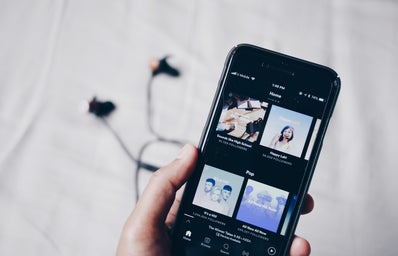As Delhi University colleges reopen offline this week starting 17th February, you will probably find me commuting via metro with my earphones in, listening to my go-to Spotify playlist for those ‘main character vibes’. But this platform, that provides us with millions of songs, tailored by algorithms to cater to our unique preferences merely at the click of a button, is not all sunshine and rainbows. Well, it might be for us consumers (except for the annoying advertisements), but the same is not the case for the artists themselves and others involved in the music-making process such as writers and composers.
First, let us go back in time a little. Before the popularity of the internet and music streaming, people had to depend on the radio or buy physical albums in the form of CDs or vinyl to listen to their favourite songs. When Spotify launched in 2008, the global recording industry had been ravaged by piracy (remember mp3skull and the viruses?) Music industry revenues had spiralled downward from 1999’s peak of over $25B to the industry’s low point in 2014, when the combined market of physical and digital sales was $14 billion.
Streaming has been the backbone of the resurgence of the music industry since then. It enables people to listen to music without having to invest money and space in digital or physical copies. For a minimal subscription fee (or even completely free with some ads), users can easily access a wide catalogue of music legally in one place on streaming services, discouraging piracy and establishing a new revenue source for artists. In 2019, the total revenue of the recording industry was just over $20 billion — with $11.4 billion of that coming from streaming. Streaming is currently the most preferred way to consume music, over CD or Vinyl. Spotify alone in 2020 paid out over $5 billion to rights holders, more than any other streaming service. Spotify, which has 286 million monthly users, compared to Apple Music’s 60 million, and Amazon Music’s 55 million monthly users – holds a clear monopoly over the streaming economy.
Spotify makes money in two ways- from subscriptions to its premium service and through running paid advertisements on its free tier. Spotify currently takes a 30% cut of the earnings, with the 70% left divided up among the rights holders based on the number of streams. The catch is that they are not paid a fixed rate per stream, instead pay-outs are calculated on a pro rata basis. All the revenue goes into one big pool and is divvied up among artists according to their share of the total streams on the platform. So, if a group of artists is getting 90% of the streams, they’re also getting 90% of the money. The problem with this model is that it favours the few top-tier artists who get the biggest amounts of plays, such as Drake and Ariana Grande, giving them the biggest share of the pie. This unfair comparison between superstars and small indie artists on the same field leaves the latter with barely enough income from streaming to meet living costs.
What makes this system of revenue distribution even more worrisome is that Spotify does not directly pay the artists and songwriters, instead money goes to the rights holders- the record labels, publishers, and distributors- who then pay the artist based on their individual contracts, which are notoriously exploitative. Other streaming platforms also follow similar methods.
According to Forbes, industry estimates vary slightly, but for 1 million plays of a song, artists receive roughly the following pay out from these streaming services: Amazon Music $5,000; Apple Music $5,000-$5,500; Google Play $12,000; Pandora $1,400; YouTube $1,700. At Spotify, which holds upward of 36% of market share, 1 million streams will earn an artist in the $3,000-$6,000 range.
A band found a clever way to game the system. Vulfpeck’s album ‘Sleepify’ uploaded to Spotify was nothing but five minutes and sixteen seconds of complete silence, that they encouraged consumers to play on a loop while they slept. The album earned $20,000 in royalties before it was taken down by Spotify for violation of its content policies. The band used the money to fund a tour where all of the shows were free of charge.
To further highlight the inequality and unfair remuneration by the current pro-rata system we can look at the findings of the investigation the British Government had launched into the economics of the streaming industry. According to the British Government’s Digital, Culture, Media and Sport (DCMS) Committee “music streaming in the UK brings in more than $1 billion in revenue with 114 billion music streams in the last year, however artists can be paid as little as 13% of the income generated”. Spotify miserably fails to live up to its promise of fair remuneration and “giving a million creative artists the opportunity to live off their art”.
Spotify has recently introduced a new feature called Discovery Mode– where an artist agrees to forfeit a percentage of their streaming income in exchange for Spotify algorithmically promoting that artists’ music to more users. This creates a pay-for-play situation which ultimately is beneficial for nobody but the platform. Listeners will be plagued by promoted tracks that may not match their tastes. Artists will receive even lesser royalties, and in the eventual situation where everybody is opting to pay to get their music promoted the algorithm will be unable prioritize, rendering the whole scheme redundant. The only beneficiary is Spotify, which be able will get away with paying artists even more miserly royalty rates.
We cannot hope to see much immediate change in this status quo that favours megastars and record labels; two major record companies — Sony Music Entertainment and Universal Music Group — continue to jointly own between six percent and seven percent of Spotify. Providing an alternative way forward, Soundcloud has introduced a ‘User-Centric’ payment model for streaming-the revenue earned by the subscription fees of a user after the platform take its cut goes only to those artists that the consumer has actually listened to. But this comes with its own set of problems, as the division of this revenue is a complicated task, and the streams of those fans that listen to a large variety of music will be valued much less than the occasional listener.
It will take the music streaming industry a while to come up with and implement a more ethical model of reimbursement that pays musicians fairly, whether under pressure or out of choice. Meanwhile, what can you do? Stream your favourite artists -whether they are rising neighbourhood stars or a foreign indie band- frequently and through legitimate channels as far as possible, giving them a larger share of the revenue pie. If you have the resources also consider buying their music (digitally or physical albums) and merch to directly support them in their musical endeavours.


